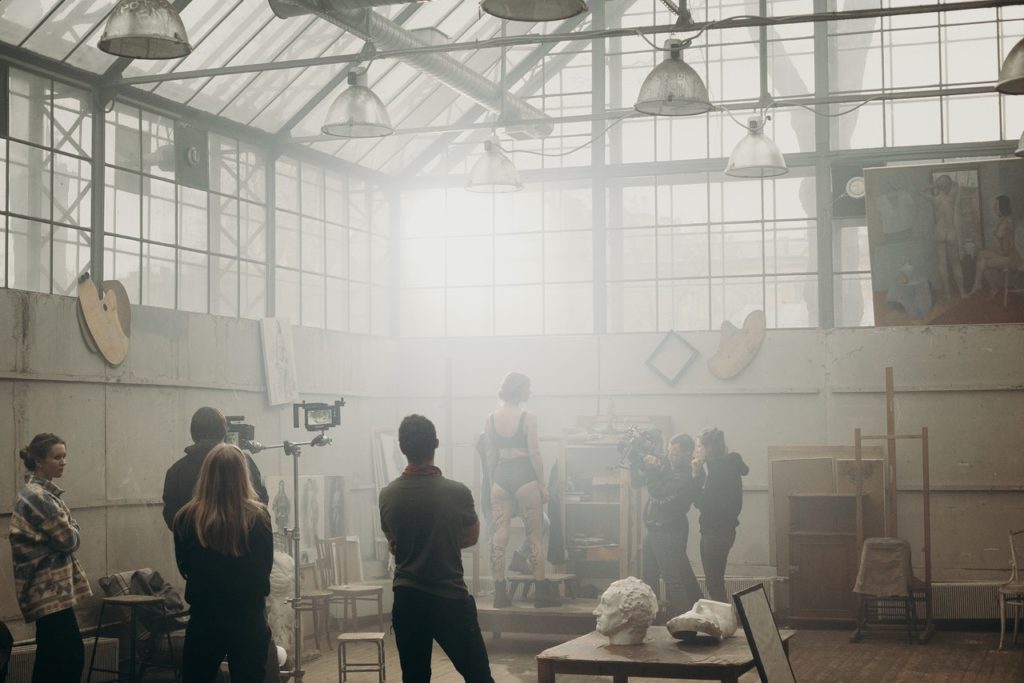Making money as an artist is easier than it seems. With a little creativity, hard work, and dedication, you can not only support yourself, but achieve true financial success.
This article shares some of the money making lessons I have learned over the years as a professional artist.
When I first tried to make a living doing art, the majority of resources I found were step by step guides. They read like get rich quick schemes and didn’t focus on the root cause.
The truth is, learning to make money as an artist is a process – a process that involves learning, growing, and thinking differently.
So if you’re looking for a get rich quick guide, look elsewhere. If you’re looking to develop a money making attitude that will help you achieve financial freedom while doing what you love to do, read on.
The two most important things that you can do to develop a sustainable and diverse income are to:
- adopt the right mindset and
- educate yourself.
Mindsets to make money as an artist
When I first started learning how to make money as an artist, I struggled. After working my ass off for several years and still coming up broke, I had an epiphany:
The same principles of free expression, spontaneity, and flow that brought me success in art were not universally applicable. In other words, art and business are not the same. To be successful in art does not necessarily translate to being successful in business. Therefore, a mindset shift was needed – I needed to think both like an artist while simultaneously thinking like a businessman.
Mindset shift #1: Think like a professional

One of the most influential books I have read on this subject is called “The War of Art” by Steven Pressfield. I cannot recommend this book enough. It’s short, to the point, and was a huge wake up call for me.
Steven Pressfield postulates that there is an invisible force within all of us that keeps us from doing our work – he calls this force “resistance”. Resistance comes in all forms but the main idea is that it convinces us to do anything other than work on our art.
He convincingly argues that the main difference between professional artists and hobbyists is that professionals consistently overcome resistance. Professionals treat their art like a job and always do their work.
This main mindset shift helped me to see myself as a professional artist and provided immeasurable context to my struggles. Make this mindset shift and you will set the stage for the rest of your artistic money-making efforts.
Mindset shift #2: Don’t be afraid to fail or look dumb
“Never be romantic about how you make your money”
Gary Vaynerchuck
I’m not going to lie, this is one that I continue to struggle with. As artists, we tend to emotionally attach ourselves to our art.
If we spend hours on a piece and it doesn’t sell, it’s so easy to get upset and start to doubt ourselves. This kind of thinking is ultimately unproductive. But we can’t help it, we love our art, so why don’t other people love it?
Oh well, maybe other people don’t get it. Maybe they’re too simple to understand the brilliance of my vision. If they don’t appreciate it, maybe I’ll just hoard my art in the basement and keep it all to myself…
Don’t think like this.
One of the hardest parts of making money is to emotionally detach from that which we love. Remember, your artistic process is separate from the business process. Put your everything into your art, but detach emotionally from the business outcomes. Learn to look at your business objectively and see it through the lens of a cold hard business person.
Just because your art isn’t selling right now doesn’t mean it sucks. It just means that it isn’t selling. Even if it does suck, that doesn’t mean that you suck. It just means that you have room for improvement. This is true for every artist and every person on planet earth so welcome to the club.
As for looking dumb, people that judge you for trying to make it as a artist are usually insecure themselves. I used to worry so much about what everyone thought of me – what my Mom or siblings, or friends thought about me painting naked girls for a living. After a while, I realized that most people don’t care. Their eyebrows might raise for a second when I tell them what I do, but they practically forget a second later.
Once in a while you will come across a particularly judgy person that cracks a “starving artist” joke. To whom you can thank for being so emotionally affected by your life choices.
You might come across the “helpful” uncle or friend that wants to give you advice on business when they have no vested interest in your success. Givers of unwanted opinions are insufferable to everyone around – no need to justify your actions to them as they look and sound dumb without assistance.
The people that care about your art are the people who you should be listening to, everyone else’s opinions are literally irrelevant.
Mindset shift #3: Share your expertise, knowledge and goodwill

Over the years, I’ve had the opportunity to meet and work with many body painters, airbrushers and artists. Some of these artists became more successful at generating business and making money than others.
The main difference that stood out to me between the people that became successful and the people that weren’t, was their attitude towards helping others.
Some artists that I worked with would hoard everything. They hoarded knowledge, advice, expertise, money, equipment and always wanted to make sure that they were treated fairly and with respect. These people came off as paranoid, always worried that others would rip them off or steal their secrets. If we collaborated on a body painting project, they would refuse to share their stencils, paints or supplies.
These people were usually worried about how much money they made and would compulsively lie about their income.
I couldn’t stand these people, and neither could much anybody else. As a result, these people generally had a hard time finding work and were unable to negotiate good business deals.
Conversely…
Some artists that I worked with were like an open book. They loved to share and make other people happy. They were always looking for creative ways to work with you to make sure that your needs were met. When we worked at body painting gigs together, they would share ideas, stencils, supplies, and put the success of the team ahead of their own. They would arrive early and help set up the body painting booth. They would give away free art to get people excited.
When we talked about money, we would have candid face to face conversations until everyone involved agreed on a fair arrangement.
For a long time, I thought that the second kind of artist was generous to a fault. How were they going to make money if they were always giving shit away?
But I eventually realized that everyone loved working with them including me! This realization completely changed the way that I looked at my business. For so long, I was trying to keep my secret sauce to myself.
I didn’t want someone else to start body painting and take business away from me!
I didn’t want people to take advantage of me and give me the shitty end of a business deal!
I didn’t want to do “free” work without getting anything in return!
So I changed my ways. I started to share with everyone. I shared exactly how to do what I do with other artists (take this article about how to start body painting for cheap and easy as an example). I started to offer my services to others for free. And, most importantly,
I started to put my customer’s needs first instead of making everything about me.
Want to know what happened? A couple people started their own body painting businesses. A few people started using my techniques, and I probably got the shit end of the stick in a few business deals.
But just like the people that I loved to work with, I started to attract a new level of attention. People wanted to work with me and wanted my business. Customers were more satisfied, aspiring artists looked up to me, and my brain started to come up with creative ways to meet people’s needs. And best of all,
I felt a deep feeling of satisfaction in my heart, like I truly had something of value to offer.
In this business, you have to give some to get some. In a world where your art is only worth as much as others are willing to pay for it, you have to build up relationships based on goodwill. Be generous, and the benefits will eventually come back to you in profit.
*Exception: Do not let people steal from you. There’s a difference between knowing your legal rights and being paranoid. See the section below about intellectual property rights.
Learning objectives to make money as an artist
“Education is the most powerful weapon that you can use to change the world.”
Nelson mandela
One of my most powerful realizations about my failures to make money as an artist, was that I didn’t know any better. My mistakes were more a reflection on my lack of knowledge than anything else.
You can take all the action in the world, but if you’re doing the wrong thing, you won’t get the results you want. On the other hand, you can learn everything there is to know, but without targeted action, you’ll be in the same place.
That’s why a good balance between taking action and learning is needed to make money as an artist.
Learning Objective #1: Work on your craft first

Have you ever found yourself running around, reading blogs (like this one), trying every new money making tactic of the day, only to stagnate and not get anywhere? This is actually very common among artists trying to make money. In entrepreneurship, there’s a term for this kind of lack of focus – it’s called “shiny object syndrome.”
Shiny object syndrome is the tendency to have your hand in 10 different honey pots without finding success in any individual one. When you’re starting out, it’s easy to get caught up in this because you want to find what works. Unfortunately, most money making tactics require hard work, consistency, and reliance on the process – there’s no true get-rich-quick methods out there.
To avoid shiny object syndrome, work on your craft first. At the end of the day, your artwork is the key element of your product or service – it needs to be impeccable. There is always room for improvement, so set aside time each week to work on your craft.
Many entrepreneurs will admit, after spending years caught up in shiny object syndrome, that if they would have just stuck with the one most important thing, they would be further ahead.
Remember what brings value to your customers. If your whole business falls apart and nothing seems to work, you can still practice your art. Start with the basics first, build a strong foundation, and you can build an empire.
Learning Objective #2: Learn about business and marketing concepts

When I first started airbrushing and body painting, I knew nothing about margins, fixed costs, or copyright laws. I didn’t know what I didn’t know, and looking back, I missed out on tons of money making opportunities because of it.
To improve my business education, I went to university to get an undergraduate degree in commerce. This was a drastic 5 year investment of my time and money, but it gave me a basic understanding of how business works.
You don’t have to get a degree, but learning business concepts is a must if you want to learn how to make money as an artist. Fortunately, education is more accessible than ever before in history. Books and the internet are available to almost everyone, so you can learn about business for cheap.
Here’s 5 business areas that I recommend learning about:
1. Managerial Accounting
Gather an understanding of basic accounting principals in terms of money in and money out. Managerial accounting is the practice of taking account of all the assets and liabilities in your business. It’s very practical knowledge and provides a good framework for handling your finances.
2. Digital Marketing
Learn how the internet works. There are literally endless money making opportunities online. The fact that you are even reading this blog means that digital marketing works. Although I took a few electronic marketing courses in school, I acquired the majority of my digital marketing knowledge from reading blogs and trying things out on my own.
You can do the same!
Start reading content from sources like:
You want to gain a cursory understanding of some of these digital marketing concepts:
- Social Media Advertising
- Pay-Per-Click advertising (PPC)
- Display Advertising
- Search Engine Optimization (SEO)
- Content Strategy
- Graphic Design
- Web Design and Web Development
Many people make their careers on this stuff so don’t get frustrated if you don’t know it all. The idea is to know what’s out there so you can identify the best money making opportunities for your business.
3. Sales
Learning basic sales concepts can make the difference between having a loyal following of engaged customers and having a few casual fans. Some important sales concepts are:
- The stages of a sales funnel
- The art of persuasion and influence (The book “Influence: The Psychology of Persuasion” by Robert Cialdini is a great intro to these skills)
- Professional Selling (Check out “Spin Selling” by Neil Rackham. It’s an excellent book on selling to make long term relationships)
Many artists don’t bother learning sales concepts because they don’t want to come off as sleazy sales people. This is too bad because they are missing out on lots of money making opportunities. After all, just because you read about something doesn’t mean you have to do it.
If you’re worried about using sleazy sales techniques, my advice would be to read about what’s out there first and then decide what you would like to implement.
4. Microeconomics
Having a basic idea of microeconomic principles is another cornerstone of business education. Microeconomics can be summed up as the relationship between supply and demand. The supply of products and their worth is linked to the demand for those products in the marketplace.
Of course it gets more complicated than that. But understanding how a capitalist economic system works is important if you want to be a successful participant.
To get a solid basis for microeconomic principles, go old school and read “The Wealth of Nations” by Adam Smith.
Like I said, you don’t need to get a degree to make good money as an artist. But the more you know about basic business concepts, the more opportunities you will find in your environment. Learn the basics, and the world is your oyster.
5. Intellectual Property Law
As a purveyor of artistic goods, you need to understand what rights you have to your creative material. These rights are generally referred to in legal terms as “intellectual property” rights. The three main areas of intellectual property rights are:
- Copyright Law: the law surrounding intellectual rights to creative works.
- Trademark Law: the law surrounding intellectual rights to names and logos of business entities.
- Patent Law: the law surrounding intellectual rights to inventions.
Knowing your intellectual rights is a caveat to the earlier section about sharing your work and knowledge freely and openly with others. Be generous, but also know what your legal rights are. This is your best defense against those that try to steal from you or try to take advantage of you.
If you know your boundaries, you’ll be in a better position to give freely to others.
Get creative and help people solve their problems to make money as an artist

In today’s digitized world, new money making opportunities are literally popping up everyday. How much money you’re able to make as an artist will be a result of how well you can capitalize on these opportunities. Make sure that you’re armed with the right mindsets and knowledge to start earning what you deserve.
As artists, creativity often comes naturally. Luckily, in a rapidly changing world, creativity is becoming more important than ever. Discipline your creative spirit, focus on providing value to others, and you will be rewarded with lots and lots of money.


